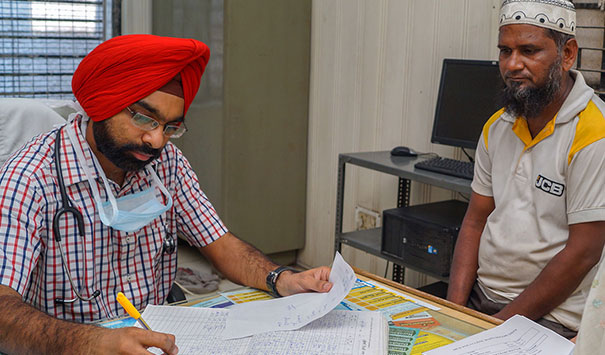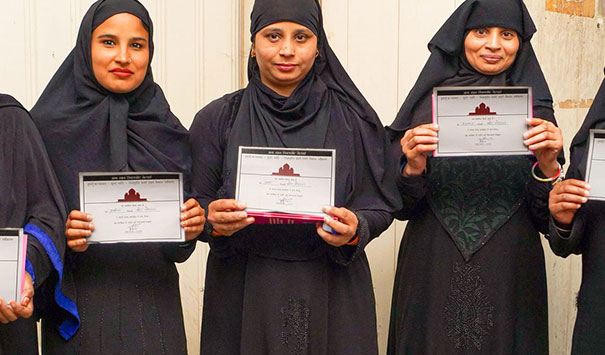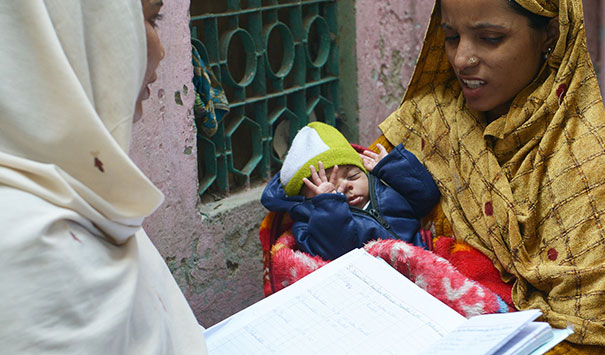"I am here because of my conviction that improving maternal, neonatal and child health should be one of the highest priorities on the global development agenda. I can think of no other field in which a well-directed effort can make as great or as rapid an impact."
- His Highness the Aga Khan
speaking at the Maternal, Newborn and Child Health Summit, Toronto
The Nizamuddin Urban Renewal Initiative has coupled conservation with socio-economic initiatives aimed at improving the quality of life for Nizamuddin Basti’s residents through simultaneous action towards providing education, health, sanitation, vocational training facilities. Furthermore, upgrading available public infrastructure, landscaping open parks, major street improvement, housing improvement, building community toilets coupled with heritage and environmental awareness programmes further help meeting project objectives and UN Sustainable Development Goals. The health programme was initiated with three desired outcomes - strengthen the health services available at the SDMC polyclinic; improve health seeking behaviour and improve health practices with a focus on maternal and child health. The strategy chosen was twofold – strengthen the delivery system while developing community health worker led mechanism to increase demand and improved monitoring. These areas were decided based on the situation analysis report, the quality of life survey and the baseline report of the All India Institute of Medical Sciences and Ambedkar University.
Till 2006, while the project was being negotiated, Basti Hazrat Nizamuddin did not have a government health facility. The nearest government health facility was the maternal and child health centre almost 3 kilometres away. The other places were the two large government hospitals in the vicinity.
Apart from maternal and child health, primary health care and out of pocket expenses are areas of concern for large parts of India but become more acute in Nizamuddin. People tended to ignore small illnesses in the absence of affordable healthcare and maternal and child health suffered with indicators that were a matter of concern.

The South Delhi Municipal Corporation had set up a
polyclinic in Nizamuddin Basti that included XX doctors and
a pharmacy. It was equipped very basically and did not have
a gynaecologist or paediatrician. The services and referral
linkages were very limited. The location of the polyclinic was
also such that it discouraged visitors. There was also lack of
awareness on the facilities that the polyclinic offered and
low faith in government services per se.
The need was to strengthen the facilities and create
mechanisms and linkages between the community and the
polyclinic.
A major challenge was also to create systems so that
visiting the polyclinic as the first point of conta ct for an
illness became the norm for the majority of the population in
Nizamuddin.
Our project interventions in the health sector aim to ensure all Nizamuddin residents have access to quality health care and referrals and to build a repository of knowledge in Nizamuddin Basti through the community health workers to bring about change in health seeking practices and health seeking behaviour while simultaneously strengthening the public health services of the local government.
Click here to download flierInstitutional
deliveries
held in 2018
compared to
67% in 2010
Immunisation
programme
covering
Malnourished
children
covered through
supplementary
nutrition programme
Medical tests conducted
in the basti polyclinic
Increased awareness
of care during and
post-pregnancy
Basti children treated
by pediatrician
In order to achieve the objectives of the project, the project engages in the following activities:

The close relationship between poverty and health has been recognised in the Bhore Committee Report and the Alma Ata declaration that investment in poverty elimination is essential for improving health which in turn would contribute to productivity and economic growth. Investment in healthcare is also seen as a form of transfer of resources to the underprivileged and therefore a form of poverty reduction. India also has one of the highest out-of-pocket expenses in the world when it comes to meeting health expenses as the public health system has several gaps.
The SDMC polyclinic is the public health facility that caters to the >10000 population of Nizamuddin, the large floating population and since its strengthening, the catchment has increased to almost 15 kilometres.

Community health workers play a central role in the preventive and promotive components of healthcare. The experience from other programmes across the world and India indicate that community health workers play the role being the link between health services and the community.
Training people, especially women from the community helps in creating repositories of knowledge who are embedded in the community and can gain their trust. They have proved to be useful in ensuring access to healthcare, in counselling, in educating communities in general and patients in particular to adhere to the medical regimen.
The community health intuitive in Nizamuddin was guided by these learnings from other programmes and the need to improve the health seeking practices and health seeking behaviour.

Health behaviour is extremely diverse and depends on many variables. In developing countries like India, it is also a function of education as well as more sophisticated theories of application of individual choice in health behaviour and their belief in what determines their health – internal or external factors.
Research has also shown that behaviour change is one of the most difficult things to achieve and yet behaviour change at the individual level has the huge potential to impact the health of communities.
It is with this background that the project embarked in the key areas of maternal and child health in which to change health seeking practices and health seeking behaviour.

The project interventions have a high focus on the continuity of institutional sustainability and building the capacities of the communities to accept change while supporting them to ensure that the change that has occurred during the project period is continues.
The major strategy that has been and is being used is to create community based groups that monitor the efficacy of the government service.